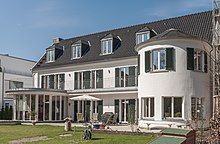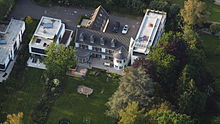Kiefernweg 12 (Bonn)
The building Kiefernweg 12 (also called (Willy-) Brandt-Villa and Blömer-Villa ) is a villa in the Venusberg district of Bonn , which was built in 1938. She was in the time of Bonn as the seat of government (1949-1999) official residence of various leaders, including the Federal Chancellor Willy Brandt , and stands as a monument under monument protection . In 2011/12 the villa was rebuilt and divided into two houses inside.
location
The villa is located as a solitary building on the southwest edge of the district at an altitude of about 170 m above sea level. NHN and borders with its park on the forest ( Kottenforst ). It is accessible via its own access road, about 50 m from the Kiefernweg.
history
The villa, whose 11,000 m² property was developed in 1935, was built in 1938 as a country house for the businessman Heinz Blömer based on a design by the Bonn architect Wilhelm Denninger . After Bonn was designated the seat of government of the Federal Republic of Germany, the family of the late Blömer offered the villa to the office of the federal capital of North Rhine-Westphalia on September 8, 1949 . As early as September 9, it was decided to make it available to SPD chairman Kurt Schumacher as his Bonn residence . On the basis of an agreement between the SPD party leadership and the state of North Rhine-Westphalia, the latter acquired the villa for 161,000 DM , had it converted for 27,700 DM and furnished for 50,000 DM, in order to make it available to Schumacher by Christmas 1949. He lived there until his death in 1952.
From 1958, the villa, now owned by the Federal Republic of Germany and a property of the Foreign Office , served as the residence of the Federal Foreign Ministers Heinrich von Brentano (until 1961), Gerhard Schröder (1961–1966) and Willy Brandt (1967–1967 ) after renovations by the Federal Building Department. 1969). In the 1960s, a kitchen wing was added to the side. Brandt lived in the villa with his family during his tenure as Federal Chancellor until 1974. Afterwards, the property was used by the Foreign Office as a guest house, at times also to accommodate state guests. After the federal election in 1998, Federal Chancellor Gerhard Schröder lived in the villa for a period of a few weeks with his then State Secretary Frank-Walter Steinmeier . After he moved out, the building was vacant because the government headquarters were relocated to Berlin (1999) and could no longer be used by the Foreign Office. In April 2000 it was listed as a historical monument , including the park and pergola . In 2002 and 2005 the villa was the location for the television films In the Shadow of Power and Shadow Fathers , in each of which Brandt's son Matthias played the leading role.
In 2007 the property was sold by the federal government to a real estate company . The plans for the renovation of the villa and a new development of the property were completed and approved after several changes in summer 2008. After repeated delays, construction work began in spring / summer 2011 and was largely completed by spring 2013. In the process, two residential buildings were created from the villa, which had been dismantled to its outer walls, the subsequently added kitchen wing was demolished for the purpose of building two residential buildings and two more single-family houses were built in the park area.
description
The villa is two-storey and consists of two wings on an L-shaped floor plan . The garden facade is defined by a semicircular porch with a pavilion-like roof finish. Before it was divided into two halves, the villa had a living space of 416 m². The dining room , kitchen and three reception rooms were on the ground floor . The upper floor accommodated the privately used rooms: two large rooms, salon , breakfast room, study (accessible via two stairs), two bedrooms and bathrooms. The top floor housed other small rooms.
The villa also has a pergola and tea house in the southern part of the park . A rust-brown low-rise building on the rear part of the property served as the guard house of the Federal Border Police. The park with a size of around 1.1 hectares includes numerous pine trees , a red beech , Atlas cedar , a silver maple and a sequoia tree .
literature
- Hermann Otto Bolesch, Hans Dieter Leicht: The long march of Willy Brandt , Horst Erdmann Verlag, 1970, p. 53 ff.
Web links
- The former Villa Willy Brandt , Villa Park Venusberg
- A relic from bygone days ( memento from February 17, 2013 in the web archive archive.today ) , Deutsche Welle Akademie, January 9, 2009
- Photo of the villa in 1956 , Federal Archives
- Willy, Rut and Matthias Brandt in the garden of Villa Kiefernweg 12 (1972) ( Memento from December 22, 2015 in the Internet Archive ), Federal Archives
Individual evidence
- ↑ List of monuments of the city of Bonn (as of March 15, 2019), p. 30, number A 3590
- ^ City of Bonn, City Archives (ed.); Helmut Vogt : "The Minister lives in a company car on platform 4": The beginnings of the federal government in Bonn 1949/50 , Bonn 1999, ISBN 3-922832-21-0 , pp. 74-75.
- ↑ We were pounded soft like chops , Der Spiegel , July 31, 1989
- ↑ Stefan Schieren: The Chancellor of a New Generation . In: Foundation House of the History of the Federal Republic of Germany (ed.): The Federal Chancellors and their Offices , ISBN 978-3-937086-14-9 , Bonn 2006, p. 156–171 (here: p. 156).
- ↑ a b "Willy Brandt Villa" sold on the Venusberg , General-Anzeiger, August 27, 2008
- ↑ Schröders Ruh ' , FOCUS Magazin , No. 44/1998, October 26, 1998
- ^ Willy Brandt's villa is about to be sold , General-Anzeiger , December 19, 2000
- ↑ Nobody wants to live in Willy Brandt's villa , General-Anzeiger, August 13, 2004
- ^ Federal government sells Willy Brandt's villa , General-Anzeiger, April 14, 2007
- ↑ Entrepreneur buys Willy Brandt's villa , General-Anzeiger, December 6, 2005
- ↑ Buyer of the Brandt Villa questions planning , General-Anzeiger, August 4, 2007
- ↑ Brandt-Villa becomes two terraced houses , General-Anzeiger, July 21, 2008
- ↑ Renovation of the Brandt Villa begins , General-Anzeiger, August 28, 2008
- ↑ Oak to Brandt-Villa must fall , General-Anzeiger, May 14, 2011, p. 33
Coordinates: 50 ° 41 '57.1 " N , 7 ° 5' 44.8" E


